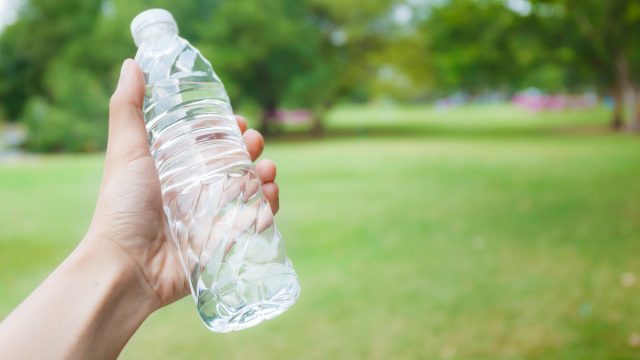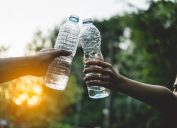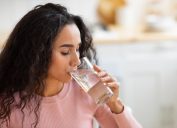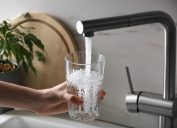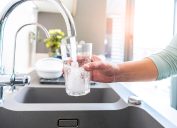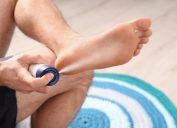"Groundbreaking" New Study Shows How Much Plastic Is in Your Bottled Water
Drinking two bottled waters can result in the digestion of 110,000 to 370,000 nanoplastics.
It's no secret that consuming beverages and foods packaged in plastic isn't exactly good for you, but just how bad is it? According to a new study published this week in the journal Proceedings of the National Academy of Sciences (PNAS), plastic water bottle containers can consist of 10 to 100 times more nanoplastics than researchers originally thought. What's even more startling is that these so-called nanoplastics are so teeny, tiny that you can't even see them under a microscope.
RELATED: What Happens If You Drink Out of the Same Water Glass for a Week, According to Doctors.
Microplastics can measure anywhere from "less than 0.2 inch (5 millimeters) down to 1/25,000th of an inch (1 micrometer)," per CNN. A nanoplastic, on the other hand, is calculated "in billionths of a meter." To put that into perspective, a nanoplastic can be described as "1,000th the average width of a human hair."
Originally, researchers estimated there to be 300 nanoplastics per plastic bottle liter. For reference, two standard-size water bottles make up one liter. However, researchers have since discovered there to be between 110,000 and 370,000 nanoplastics per liter—at minimum.
The discovery was made possible after researchers from Columbia University unveiled a brand-new technology that's specifically designed to scan and analyze nanoparticles in packaged water. According to Beizhan Yan, an environmental chemist and co-author of the study, these potentially harmful nanoparticles can be "inorganic nanoparticles, organic particles and some other plastic particles not among the seven major plastic types we studied."
Experts specifically warn that nanoplastics' miniscule size makes them a dangerous threat to consumers' health. Because nanoplastics are microscopic, they have the power to infiltrate our body and, in some cases, our bloodstream. Along the way, these nanoplastics may release synthetic chemicals, which can potentially hurt our health.
Considering how much water the average person drinks in a day, and how that correlates to the number of microplastics and nanoplastics we are simultaneously pumping into our system when drinking out of plastic bottles, it seems alarming.
"It is estimated you eat about a credit card's-worth of plastic a week, and these invisible particles are one of the main culprits," Heather Wilde, NMD, a naturopathic doctor in Tempe, Arizona, previously told Best Life, in reference to a 2019 report from the World Wildlife Fund (WWF).
Though the study in PNAS raises alarm bells, experts say the new discovery is "groundbreaking" in the fight against plastic packaged goods.
"This study, I have to say, is exceedingly impressive. The body of work that they put into this was really quite profound… I would call it groundbreaking," Sherri "Sam" Mason, director of sustainability at Penn State Behrend in Erie, Pennsylvania, told CNN.
There's still a lot of work to be done, but Mason explained that there are steps you can take to limit your exposure to these potentially harmful chemicals.
The most obvious way is to replace bottled water with a reusable container made from glass or stainless steel. Additionally, steer clear of foods and drinks wrapped in plastic, or at the very least, don't store food items in plastic containers.
"People don't think of plastics as shedding but they do," Mason explained to CNN. "In almost the same way we're constantly shedding skin cells, plastics are constantly shedding little bits that break off, such as when you open that plastic container for your store-bought salad or a cheese that's wrapped in plastic."
